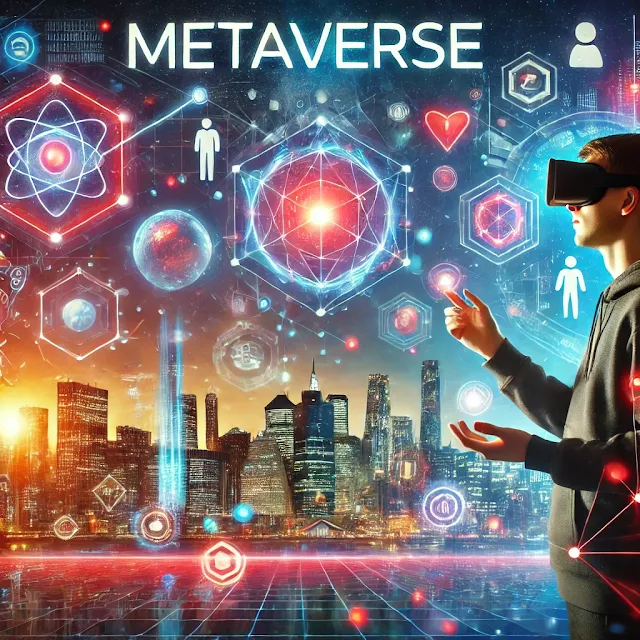The Metaverse: Redefining Digital Interaction | The Clairifiers
The metaverse is one of the most talked-about trends in technology today. It’s a virtual world where people can interact, work, play, and shop—just like in real life, but in a digital space. Think of it as the internet brought to life in 3D, where instead of scrolling through pages, you walk through them using an avatar (a digital version of yourself).
Imagine attending a virtual concert, trying on clothes in a virtual store, or even collaborating with your team in a virtual office—all without leaving your home. The metaverse is designed to bring the physical and digital worlds closer together.
What is the Metaverse?
The metaverse is not just one place. It’s a network of many virtual spaces connected by the internet. It uses advanced technologies like:
- Virtual Reality (VR): VR creates a fully immersive digital environment where you can look around and interact as if you were really there.
- Augmented Reality (AR): AR adds digital elements to the real world. For example, imagine seeing virtual furniture in your real living room before you buy it.
- Blockchain: Blockchain ensures secure transactions and ownership of digital assets like NFTs (non-fungible tokens).
Applications of the Metaverse
The metaverse is already being used in many industries. Here are some real-life examples:
Gaming: Games like Roblox and Fortnite have created their own metaverses, where players can socialize, compete, and even attend virtual events.Challenges of the Metaverse
While the metaverse sounds exciting, there are some challenges:
Privacy Concerns: The metaverse collects a lot of personal data. Ensuring user privacy and security is a big challenge.
Accessibility: High-quality VR devices and fast internet connections are expensive, making it hard for everyone to access the metaverse.
Addiction: Spending too much time in the metaverse could lead to people ignoring their real-life responsibilities.
The Future of the Metaverse
Big tech companies like Meta (formerly Facebook), Microsoft, and Google are investing heavily in building the metaverse. In the future, the metaverse could become:
- A place where people conduct business, attend school, and socialize.
- A new economy where digital goods and services are bought and sold.
- A way to bridge the gap between physical and virtual realities.
The metaverse is still in its early stages, but it has the potential to change the way we live, work, and interact with the world.
Real-Life Examples of the Metaverse
Here are some real-world ways the metaverse is being used today:
- Fortnite and Roblox: These popular online games are more than just gaming platforms; they are mini-metaverses. Players can attend virtual concerts, such as Travis Scott and Ariana Grande’s performances in Fortnite, where millions of fans gathered online. Roblox goes even further by allowing users to create their own games and worlds, making it a creative metaverse for players of all ages.
- Meta (formerly Facebook): Meta is building Horizon Workrooms, a virtual office space where coworkers can have meetings in VR, share documents, and work together using avatars. Meta’s vision is to create spaces for both professional and personal interactions.
- Decentraland: Decentraland is a virtual world built on the blockchain, where users can buy, sell, and build on their digital land. It’s a fully decentralized metaverse, meaning that users have full ownership of their assets, such as buildings, art, and even businesses within the virtual world.
- Virtual Shopping: Luxury brands like Gucci have created virtual stores and even virtual clothing that people can buy for their avatars. This is often done in collaboration with platforms like Roblox, where users can try on virtual fashion items before making a digital purchase.
- Education and Training: Schools and universities are experimenting with the metaverse to make learning more interactive. For example, in a virtual biology class, students can explore 3D models of cells or conduct experiments in a simulated lab environment. Companies like ENGAGE and AltspaceVR are creating educational spaces in VR where students can interact with their environment rather than simply listening to lectures.
Conclusion: The Future of the Metaverse
The metaverse is still in its early stages, but it has enormous potential to transform the way we live and interact. It could bring new opportunities for businesses, education, social interaction, and entertainment. However, there are challenges that must be addressed, such as privacy concerns, accessibility for all users, and ensuring a healthy balance between virtual and real-life activities.
As technology advances, the metaverse will likely become a more significant part of our daily lives. Companies like Meta, Google, and Microsoft are investing heavily in it, signaling that this digital universe may soon become mainstream. Whether for work, play, or socializing, the metaverse is a bold step toward a future where the lines between our physical and digital worlds are increasingly blurred.
Thank You So Much For Reading Till End!
Please share this post with your Loved Ones & whoever else needs this.


Post a Comment